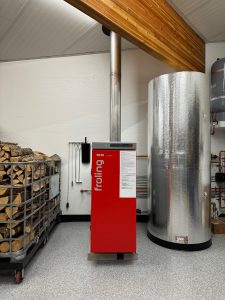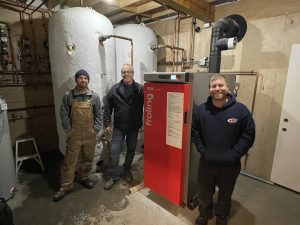Your one-stop-shop of articles, resources and answers to the burning questions.
All about buffer tanks
A buffer tank, sometimes called an accumulator tank or thermal storage tank, should ALWAYS be used with a firewood or wood pellet boiler.
All of the buffer tanks sold by Biothermic are made in North America, are of the highest quality and meet local pressure vessel regulations.
Why you need a buffer tank for boilers?
There are a couple main reasons to always use a buffer tank with a biomass boiler: stabilizing the heat output and reducing boiler cycling.
Stabilizing Heat Output
Biomass boilers, especially those using solid biomass fuels like wood pellets or wood chips, can have variable heat outputs. The combustion of these fuels may not always match the heating demand of the building. A buffer tank helps to smooth out these fluctuations by storing excess heat when the boiler is producing more than needed and releasing it when the demand is higher than the boiler’s current output.

A firewood boiler should always be teamed with an appropriately sized buffer tank. We provide custom schematics for your system.
Reducing Boiler Cycling
Biomass boilers are typically most efficient when operating at or near their rated capacity. Frequent starting and stopping of the boiler, known as cycling, can decrease efficiency and increase wear and tear on the equipment. A buffer tank allows the biomass boiler to operate at a more stable and efficient output, reducing the frequency of on/off cycles.
How do I choose buffer tank size
When you buy a boiler or buffer tank with Biothermic, we’ll always work with you to size a buffer tank for your specific project.
In general, the size of the buffer tank needed depends on the fuel type, boiler size and some customer preferences. An undersized buffer tank can lead to inefficiencies, shorter system life and more wood burned. A bigger buffer tank is usually better, but overspending on a large tank is not helpful either.
Firewood boilers always require a larger buffer tank than pellet boilers. Wood pellets are a very dry and predictable fuel and so a pellet boiler can automatically turn off and on more quickly and so needs a smaller thermal storage volume.
Firewood boilers are loaded with a larger amount of fuel and can’t shut off after ignition without causing very poor combustion resulting in smoke and creosote. The firewood batch needs to burn through at a high temperature and output and so a larger buffer volume is needed to store the excess thermal energy.
These are some examples of appropriate boiler and buffer tank systems:
• Fröling S3 30 kW firewood boiler – one 400-gallon buffer tank
• Fröling S3 50 kW firewood boiler – two 400-gallon tanks
This buffer size above, matched to the heat demand of the building, should allow for loading the boiler a maximum of twice per day during peak winter heating.
• Fröling PE1 20 kW pellet boiler – 80- to 119-gallon tank
• Fröling PE1 35 kW pellet boiler – 119-gallon tank
This buffer size for pellet boilers will allow for continuous automated heating.
What is the cost of a buffer tank
Buffer tanks are a significant part of the cost of a setting up a complete system. We offer several options for different system configurations, but there are two common sizes: the 400-gallon tank and the 119-gallon tank.
400-gallon ASME steel buffer tank
This is our most popular choice for buffering the Fröling S3 firewood boilers. It’s a steel tank with enough tappings for any installation and is the most affordable choice for an ASME tank of this size (pressure vessel regulations require and ASME certification for any pressurized tank over 119 gallons in volume). This tank costs $4,450 plus taxes and shipping to you.
Smaller tanks with shorter heights are also available. Please contact us for a schematic with dimensions.
119-gallon insulated buffer tank
We’ve chosen the Buffmax 120 tank made by Thermo 2000 as the best option to buffer the Fröling PE1 pellet boilers. We provide it for a cost of $3,500 plus taxes and shipping to you. It’s also available in larger and smaller sizes.
Insulating a buffer tank
The larger buffer tanks for firewood boilers are supplied without insulation and will require insulation on site.
There are three ways to insulate the tank or tanks, depending on your preference:
Spray foam insulation. You can apply one or two layers of spray foam to the tank which provides a fantastic R value. You’ll need to protect the tappings and fittings with tape or cardboard to keep the spray foam away from them.

This firewood boiler’s 400-gallon tank is insulated with spray foam.
Tank Wrap insulation. Foil-lined tank wrap should be available locally in various thicknesses. We suggest at least a 2” thick wrap. This can be done cheaply and easily. Tank wrap products should be available to you locally.

This Fröling S3 30kW boiler’s 400-gallon tank is insulated with simple tank wrap.
Surrounding insulated studwall. You can build a wall around the tank and then insulate the space with typical fiberglass batt insulation. This can be done easily and cheaply and can give you additional wall space in the room.

This Fröling S3 50kW boiler uses two 400-gallon buffer tanks. The space was filled with batt fiberglass insulation and then covered with ½” plywood.
Shipping and receiving larger firewood boiler buffer tanks
Buffer tanks are shipped to you in the horizontal position on a skid. The 400-gallon buffer tank weight just over 700 pounds. There are two lifting lugs at the top of the tank that can be used to stand it up. Be cautious of the height and refer to the shop drawing for your tank. You are able to lift the pallet with 4’ long forks but no shorter.

Caption of below: A 400-gallon tank is shipped horizontally like this.
Installing a buffer tank
We will provide you with a schematic for your system that will show you how it is piped. There are a few variables that we have considered in providing you with the right schematic.
All tappings are NPT and of different sizes. We can provide you with a kit of fittings for your exact system, otherwise the fittings can be purchased at your local plumbing wholesaler.
Male sure to follow the schematic closely as the proper flow of heat through the buffer tank is critical to great boiler performance.

An example of how two buffer tanks are connected in a series which allows for thermal stratification across both tanks.
A note on making your own buffer tank
We often get asked if it’s safe and possible to make your own buffer tank.
Buffer tanks are not a technically complex item and can, in theory, be created in various ways. But there are some critical points to consider:
• The tank must be vertical to allow for good thermal stratification. This makes warmer water available longer so that you can go longer between boiler firings.
• The tank must be pressurized to handle system pressure which is regulated by a 30-PSI pressure relief valve. If you use a non-pressurized tank, you will need a heat exchanger between the firewood boiler system and the tank. Read more about pressurized vs. atmospheric systems.
• If the tank is pressurized, an inspector may require that it be ASME stamped. This is common in commercial settings but maybe not in residential installations.
So, do you really need a buffer tank?
Yes!
Some companies that sell biomass boilers may claim that you don’t need a buffer tank. We ALWAYS recommend a buffer tank and so should all biomass boiler manufacturers.
The cost of a tank is considerable, and it would be financially attractive to skip it, but the absence of a buffer tank will cause your system to burn more wood and reduce its overall lifespan.
In the end, a buffer tank will help your boiler work better and last longer, saving you money.
